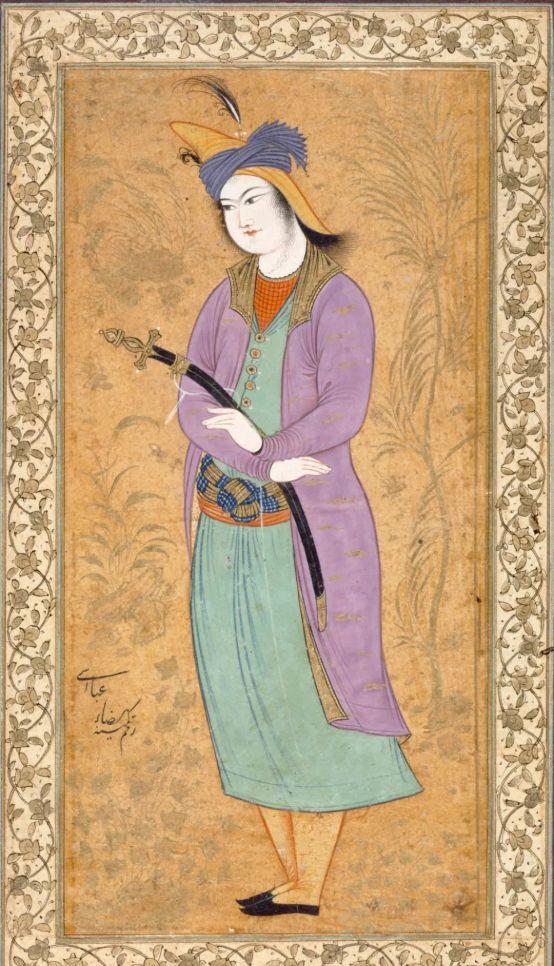Virtual pole press: a knife, straight or straight, bent or not, the same is the day when the knife head licks blood, the most feared is the soft knife that kills people and does not see blood!
Cultural inclusion refers to the internalization phenomenon that occurs when different cultures come into contact with each other, and this process includes many stages such as acceptance, synthesis, and creation, through which culture absorbs external factors to enrich itself. Cultural inclusion is different from both cultural confrontation and cultural assimilation, which is a process of systematic absorption, transformation and reconstruction of foreign cultures and heterogeneous cultures, and at the same time it is also a process of revaluation, reflection and transformation of local cultures. The artifacts depicted in his works by the Persian miniature painting Holy Hand Abasi in his works perfectly embody the fusion of Eastern and Western art.

▲ Reza Abbasil"Defender's Satchel Diagram"
1622-1624, watercolor on paper, gold miniature, 17.8 x 8.9 cm
Collection of the Detroit Museum of Art, USA
This "Defender's Shoulder Knife Diagram" recreates for us the majesty of the Damascus machete in the 17th century. "Double-edged sword, single-edged knife, straight sword machete" seems to be the conclusion of ancient and modern China and foreign countries, but in fact, in the Middle Ages, whether it is Persia or The Tang Dynasty, the knives used by people are straight blades, more like swords, easy to stab, the purpose is to cause fatal penetrating wounds to the opponent, when the cutting function of the knife is not as prominent as later generations. The bending of the knife is a gradual process, but also the result of the mutual inclusion of heterogeneous cultures.
▲ The four basic styles of tang knives
After the fall of Sassanid Persia, a large number of excellent Persian swordsmiths poured into China to avoid war and chaos, and they not only improved the production process of Tang swords, but also made them more western in decoration. The combination of Persian craftsmen who mastered advanced knife-making technology and the efficient official handicraft system of the Tang Dynasty laid the foundation for the development of Tang swords and even later Generations of Chinese swords. After the Tang knife technique spread to the northern Turkic regions, the Turks who were accustomed to light cavalry tactics found that the straight-forward Tang knife was not suitable for slashing on horseback. Thus, curved Turkic knives began to appear, and with the expansion of the Seljuk Sultanate and the Delhi Sultanate, the influence soon spread to the supply of Damascus knives - Persia and India. Since then, the crescent-like Damascus machete has replaced the ancient Arabian straight sword and eventually become the most iconic Muslim weapon.
▲ Persian machete in the 19th century
In Persia, the machete had a figurative scientific name, Shamshir, which means "lion's claw." The curvature of the machete is very large, and it can reach a curvature of 15 degrees from the bottom to the top, but there is no risk of breaking. Shamschel's cross-section is narrow and the top is sharp as a hook, which is reminiscent of the "Wu hook" of the Spring and Autumn Period; Shamschel's handle is relatively simple, only made of wood or animal horns with brass or steel to be simply decorated; the tail of the handle is slightly off to one side of the spherical nose, which can offset part of the centrifugal force.
▲ Persian machete made of Damascus steel in the 16th century
The form of Shamschel was derived from various local machetes in the process of spreading to the surrounding areas, such as Kilij or Pusat in Turkey, Talwar in India, and Saif in Arabia, all derived from Shamschel, and even the sabre around the waist of modern European officers is actually a variant of this machete.
▲ [Safavid Persia] "Heavily Armed Uzbeks"
Mid-16th century, 17.3 x 10.5 cm
Since the fall of China from the Song Dynasty, the northern nomads have repeatedly entered the Central Plains, and the traditional oriental straight knife has also begun to have a tendency to be bent.
▲ [Qing] Anon. "Qianlong First Class Bodyguard ZhanYin Bao Statue"
1760s, colored vertical axis in ink on silk, 188.6 x 95.1 cm
Collection of the Metropolitan Museum of Art, New York, USA
▲ [QingQianlong] Jade handle golden peach skin sheath cold front waist knife, through the length of 96 cm
Collection of the Palace Museum
Although the curvature of the Waist Knife of the Qing Dynasty did not reach the exaggerated level of Shamschel, the upwardly upturned blade, the slightly curved sheath and the spherical nose with the tip of the handle slightly deviated, all signs revealed that the ancient Chinese knife had been bent with the times. A knife, straight or straight, bent or not, what remains unchanged is the day when the knife head licks blood, and the most feared is the soft knife that kills people without blood!